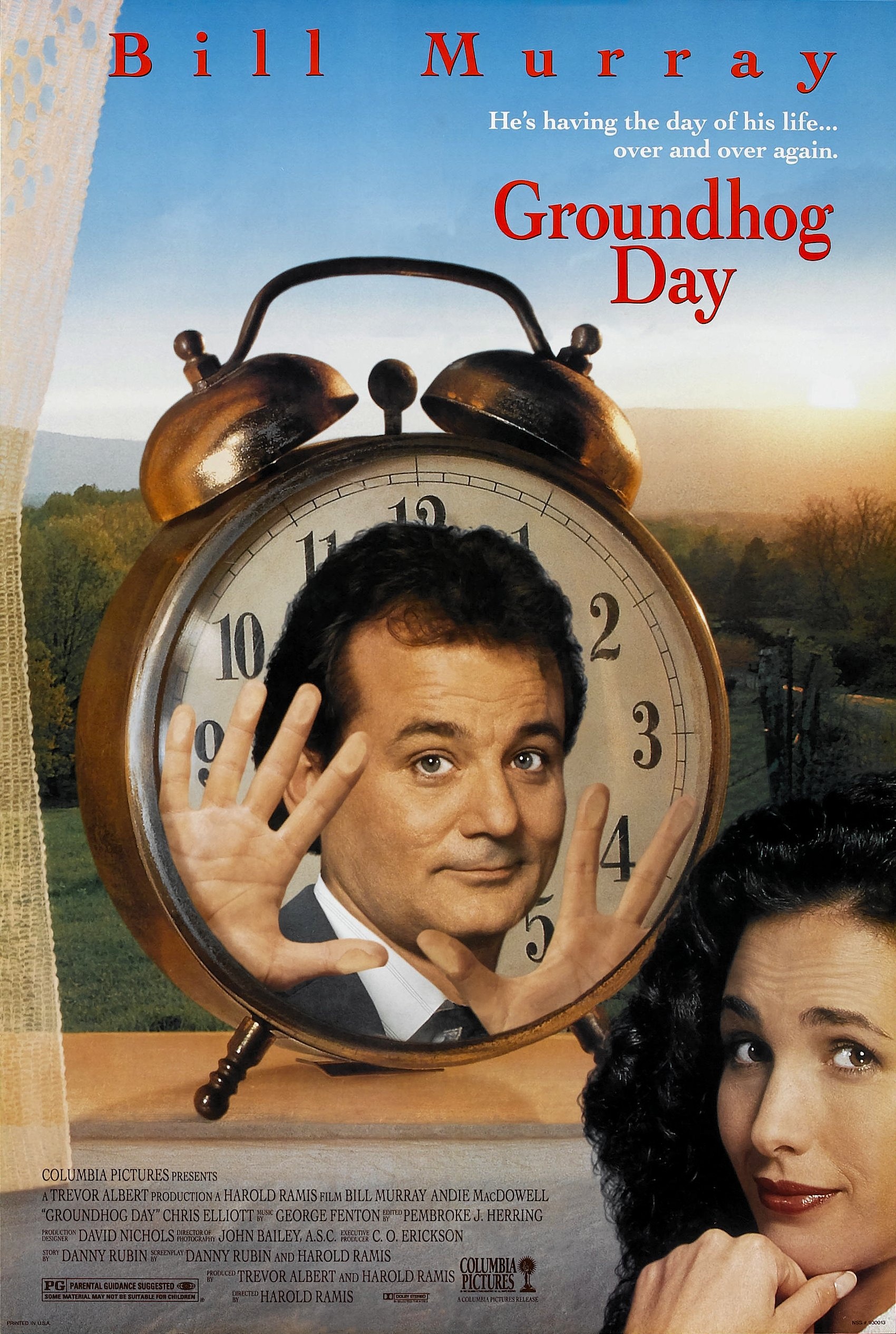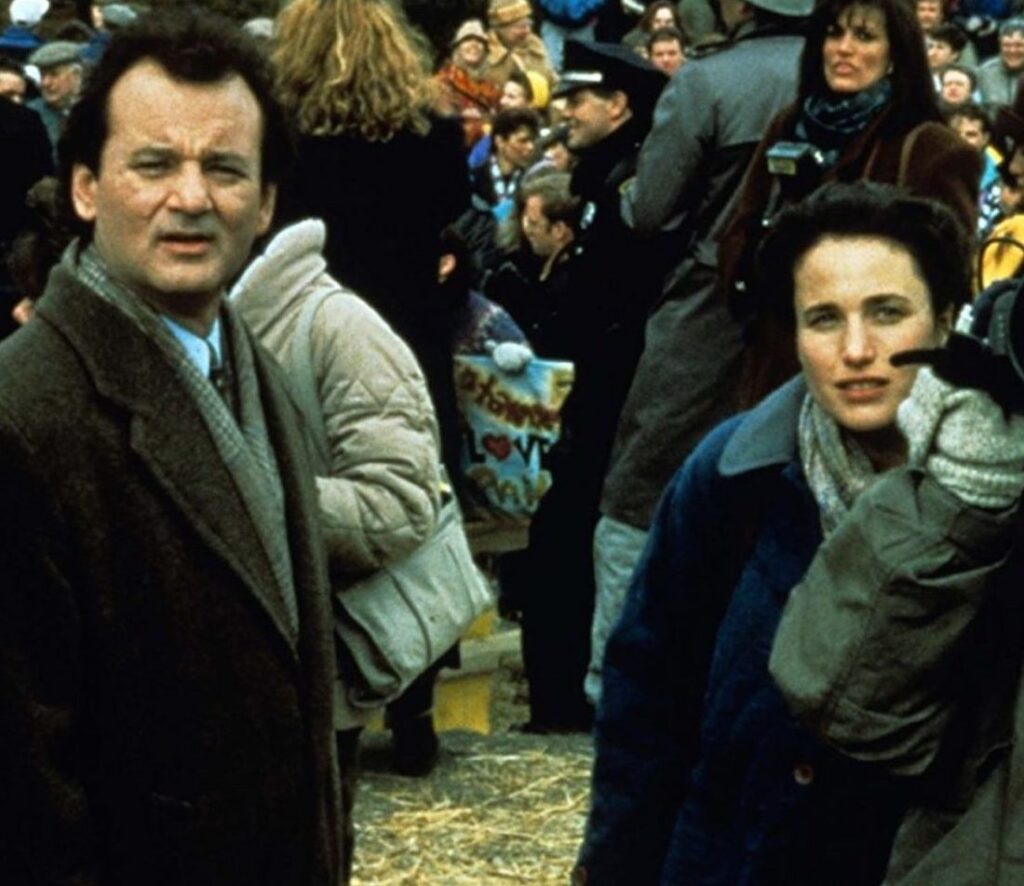
Trigger Alert: there are casual references to drinking and a number of comments by several characters voicing loneliness and despair about what never changes in their lives, including several suicide attempts depicted comically. If you are troubled by these elements, take time and space.
Life Doesn’t Change Until You Surrender to It
Believe it or not, it’s a 1st Step Film.
A cynical TV weatherman relives the same day repeatedly when he goes on location to the small town of Punxsutawney to film a report about their annual Groundhog Day. His predicament drives him nearly insane until he learns to surrender to what life is giving him.
Main Characters
- Bill Murray – Phil
- Andie MacDowell – Rita
- Chris Elliott – Larry
- Stephen Tobolowsky – Ned
- Brian Doyle-Murray – Buster
Plot
Weatherman Phil Connors reassures Pittsburgh viewers that an approaching blizzard will miss Western Pennsylvania. He goes with news producer Rita Hanson and cameraman Larry to Punxsutawney, Pennsylvania, to cover the Groundhog Day festivities. Phil makes no secret of his contempt for the assignment, the small town, and the “hicks” who live there.
The next day, Phil awakens at his Punxsutawney bed and breakfast to Sonny & Cher’s “I Got You Babe” on the clock radio. He tapes a half-hearted report on Punxsutawney Phil and the town’s festivities. Rita wants to stay and cover other events, but Phil wants to return to Pittsburgh. The blizzard blankets the region in snow, stranding them in Punxsutawney. He shuns the celebrations and returns to bed early.
And so it begins.
Phil wakes up to “I Got You Babe” and the same DJ banter on the radio and discovers the day’s events repeating exactly. Phil relives the day and returns to bed, assuming it was a dream, but it is still Groundhog Day when he wakes again: he is trapped in a time loop that no one else is aware of. Realizing there are no consequences for his actions, he spends the first several loops indulging in binge drinking, one-night stands, and reckless driving. After spending several loops trying and failing to court Rita, he becomes depressed and attempts to take his life several times, but cannot escape the loop. He keeps waking up to the same alarm and the same radio broadcast every day. Desperate for a solution, Phil goes as far as to kidnap Punxsutawney Phil and drive off a cliff, hoping that killing the groundhog will end his curse.
Things are Harder to Explain When You Can’t Surrender to Reality
Phil tries to explain his situation to Rita, for whom he has feelings, by accurately predicting the day’s events. Rita sympathizes, and they spend the entirety of one loop together, but Phil wakes up alone as usual. He decides to use his knowledge of the day’s events to better himself and the lives of others; he learns how to play the piano, sculpt ice, and speak French but cannot prevent the death of a homeless old man.

Phil enthusiastically reports the Groundhog Day festivities during one loop, amazing Rita. They spend the rest of the day together, with Phil impressing her with his apparent overnight transformation and charitable deeds. She successfully bids for Phil at a charity bachelor auction. Phil makes an ice sculpture of Rita’s face and tells her that no matter what happens, even if he is doomed to continue awakening alone each morning forever, he wants her to know that he is finally happy because he loves her. They retire together to Phil’s lodgings. Phil wakes up to “I Got You Babe” again but finds Rita still in bed with him; he has escaped the time loop. He tells Rita he wants to live together with her in Punxsutawney.
Life Grows on You
The film’s initial critical response was modest. Critics generally found it a satisfying entertainment, and its critical reputation has grown over the years. Roger Ebert revised his review when the movie began to attain cult status some ten years after its release.
The film has been described as the definition of Purgatory by some in the Christian traditions; it has also been claimed by many Buddhists who see the film as an illustration of how the cycle of Samsara, of being fated to live absently and frustratingly driven by our desires and our own habits day after day, can be broken through engagement and intimacy with the moment.
A 1st Step Film About Surrender?
At first glance, Phil seems to be a cynical, world-weary professional who has not given up on life but has given up on challenging himself. But as the world continues to repeat itself over and over again, we see Phil for who he has always been: lonely, isolated, and living an unmanageable life. It is only when Phil, after waking up on the same day thousands of times, finally surrenders to the life he’s given and begins to care about others that the cycle is broken.

Questions for consideration:
What’s his reaction when Phil first realizes he’s just living the same day repeatedly?
When you can get away with anything, does that make it more fun or less fun?
Phil nearly seduces Rita. Why doesn’t he? What’s her reaction? What’s his?
What function does Larry serve in the film? Is his reaction to Phil consistent?
Whose life can’t be changed by Phil, no matter how many approaches he tries? What’s his reaction?
Does the falling boy ever thank Phil? How does his reaction to that change over the course of the movie?
What happens to break the cycle?
Final Questions:
Do we have to know what we’re surrendering to?
For those who find the articles of faith in the 12 Steps off-putting, Groundhog Day offers some insight without the overtly religious overtones. Phil at first thinks he might be a god “Not THE God, I think…”, but soon begins to experience the odd fact that no matter how much he learns about the day he is living (by some accounts, he lives over 30 years of the same day), it is only by surrendering his will to control the day that he can emerge from it.
How do we fool ourselves with our own idea of control, especially in early recovery? How do we see beginners in sobriety attempt to control every aspect of their lives immediately after detox? What tends to happen with that goal?
And at the end of the day, compare this film to The Serenity Prayer. What do they have in common? How would you explain this film’s relevance to our shared condition to a normie who doesn’t understand our steps? How do we acquire the wisdom to know the difference?
More About Cinematherapy and Surrender:
1st Step Films




Hi, this is a comment.
To get started with moderating, editing, and deleting comments, please visit the Comments screen in the dashboard.
Commenter avatars come from Gravatar.